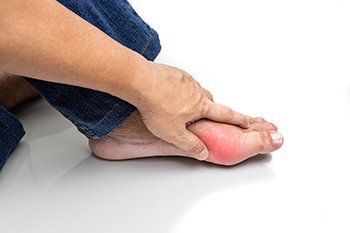
There may be evidence that kidney disease and the foot condition that is known as gout are connected. Gout is an extremely painful ailment that affects the joints in the big toe. It is caused by excess uric acid in the blood which may happen from eating foods that have high levels of purines. The kidneys break down the uric acid, and existing kidney disease may inhibit the ability to do that. Foods that fall into this category can include shellfish, red meat, excessive amounts of alcohol, and drinks that are made with large amounts of sugar. The uric acid forms crystals in the joints of the toes, often beginning with the big toe. This is known as a gout attack and it generally happens suddenly. In addition to the debilitating pain that often accompanies gout, common symptoms can include a limited range of motion, and the affected toe can become red from inflammation. If you have one or frequent gout attacks, it is strongly urged that you are under the care of a podiatrist who can speak to you about effective prevention techniques.
Gout is a foot condition that requires certain treatment and care. If you are seeking treatment, contact one of our podiatrists from Associates in Podiatry, PC. Our doctors will treat your foot and ankle needs.
What Is Gout?
Gout is a type of arthritis caused by a buildup of uric acid in the bloodstream. It often develops in the foot, especially the big toe area, although it can manifest in other parts of the body as well. Gout can make walking and standing very painful and is especially common in diabetics and the obese.
People typically get gout because of a poor diet. Genetic predisposition is also a factor. The children of parents who have had gout frequently have a chance of developing it themselves.
Gout can easily be identified by redness and inflammation of the big toe and the surrounding areas of the foot. Other symptoms include extreme fatigue, joint pain, and running high fevers. Sometimes corticosteroid drugs can be prescribed to treat gout, but the best way to combat this disease is to get more exercise and eat a better diet.
If you have any questions please feel free to contact our offices located in Pittsburgh-South Hills, and Pittsburgh-Bellevue, PA . We offer the newest diagnostic and treatment technologies for all your foot and ankle needs.









